Should you host live events on social media or your own website?
The short answer is both! Sprii gives you the opportunity to stream the same video feed to Facebook, Instagram, and your website. Learn more here.


By now, most of us agree that live shopping is amazing. It is a phenomenal way of creating brand awareness, becoming top-of-mind, fostering customer loyalty, promoting products and services, providing an entertaining shopping experience, humanizing your corporation, getting to know your customers’ preferences, boosting your sales rate… and the list goes on.
The question is not whether you should start hosting live events, but where you should do it. Some retailers choose to go live on social media, while others prefer streaming live from their own websites. Others again go live on dedicated live shopping apps or platforms such as Sprii.live.
Would you like to know the pros and cons of each option? Then you’re in luck because here is a full rundown.
Onsite live shopping
How it works
Let’s start with the option that most online stores consider first: Onsite live shopping. In all simplicity, this means embedding a live video directly on your website from which your customers can shop.
Most third-party software solutions supporting onsite live shopping will give your customers a smooth and easy shopping experience. Typically, the customer will make his purchase by clicking on a product shown in a handy product overview reflecting the items presented in the video. The product overview may include photos and info about available sizes and colors.
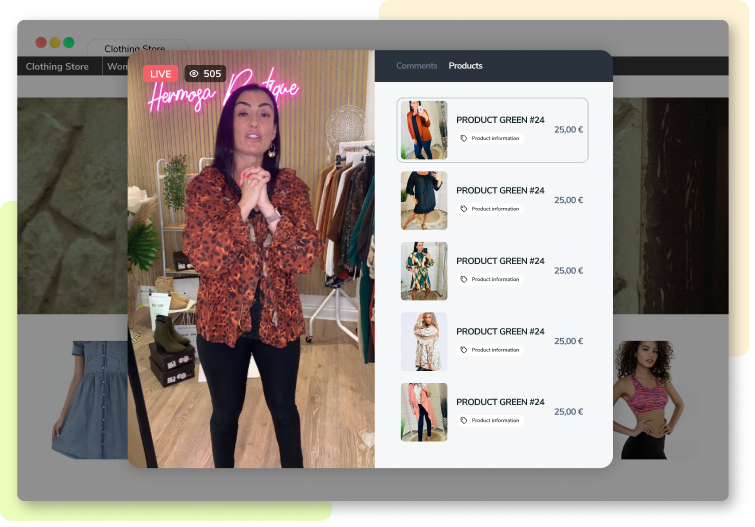
Pros
There are multiple benefits of going live on your website. First, it is easy to collect and track user data because you drive traffic through your own domain. When entering your website, your visitors will accept cookies which you can utilize for retargeting and re-engagement purposes.
Additionally, offering live shopping on your website is a great way to set you apart from your competitors. Consumers can choose between millions of webshops when they wish to shop online. Sharing entertaining and inspiring videos might be exactly what you need to stand out from the crowd.
Another advantage is that you can build a whole universe of exciting and informative video content on your own website, which you can link to in various marketing-related contexts. This option is particularly relevant if you produce live shows where parts of the content have a long lifetime.
Finally, you are guaranteed to get viewers who are genuinely interested in and actively seeking your products. After all, they visit your website because they are already familiar with your brand or because one of your paid ads has caught their interest. Most likely, this prior knowledge and genuine interest will result in a high conversion rate since your audience is invested from the beginning.
Great! Then what about the negatives?
{{20x-banner}}
Cons
For starters, the technical setup for hosting onsite live shopping events is typically more time-consuming and requires more resources. Because going live on your website is usually a large undertaking, it is not something you try out once or twice to determine if it suits you. Instead, you must be relatively invested from the beginning and simply hope your efforts will be worthwhile in the end.
Another disadvantage is that driving traffic to your website at a specific date and time is incredibly difficult and equally expensive. Getting a large audience to actively enter your website and view your live stream requires great effort from your marketing team and a big budget for advertisement. This is time, effort, and money that might be spent better elsewhere unless you have unlimited resources.
Furthermore, the social aspect of live shopping is not as strong. On social media, your viewers can tag each other and thereby share your content with their friends and family. This tagging-option is rarely available for onsite live shows. You will also often see people address each other in the comments section, sharing anecdotes, tips, or their own experiences with certain products. Some of this is lost when exclusively broadcasting your live stream on your website. While there is a comments section where your viewers can interact, it’s not always possible to see each other’s full names and profile pictures.
Finally, an onsite live event creates little to no brand awareness since your audience must know about you in advance to participate. Of course, you can spend as much money as you wish on promoting your event elsewhere such as on social media, but the event itself does not boost your reach. Why is this critical? Because people cannot purchase your goods if they do not know you exist. Consequently, a top priority for any brand or retailer is to create as much awareness as possible.
For the reasons listed above, small or relatively unknown brands rarely benefit from hosting live shopping events exclusively on their website. However, well-known brands with large advertisement budgets and marketing teams can surely benefit from going live on their own websites.
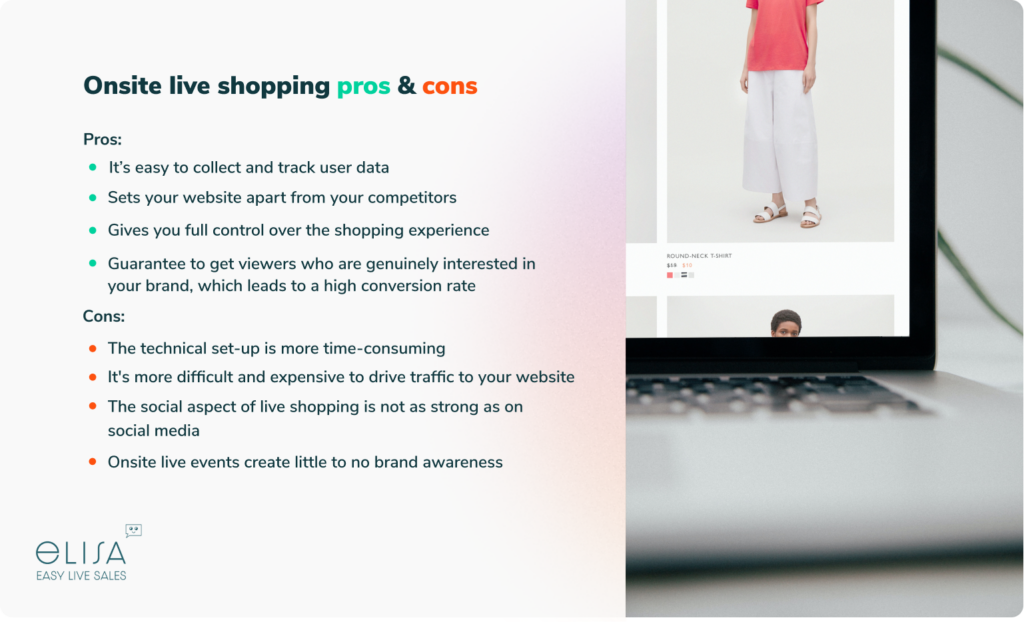
Live shopping on social media
How it works
You can turn your social media channels into sales channels by selling your products through both live videos and/or static posts depending on your preferences.
For example, you can post a photo on Facebook along with a time-limited offer and let your customers buy the product by writing a specific product code in the comments section below the post. The same procedure goes for live-streamed videos and prerecorded videos. On Instagram, you can even sell your goods via Stories, Reels, and Carrousels in addition to the videos and static photos in your feed.
Successful live shopping on social media requires the use of third-party software that can take care of the often heavy administrative work involved. There are as yet only a few tools that successfully manage to take over the workload from the business and at the same time provide the liveshopper with an easy and simple buying journey.
Sprii responds to your customers’ comments, takes orders by integrating with your inventory, sends private messages to buyers with relevant information, makes friendly reminders to all interested before a new show, supports contests and other activities to increase engagement – and much more.
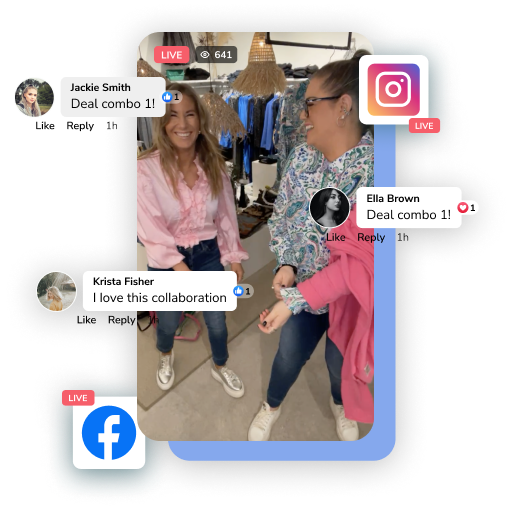
Pros
The advantages of hosting live shopping events on social media are closely related to the popularity of social media and the construction of social media algorithms. But before diving into all that jazz, allow us to highlight some thought-provoking data.
Social media such as Facebook and Instagram are more popular than ever. Close to 3 billion people are active on Facebook. This is 36% of the world’s population and more than the population of China and India combined.
Likewise, Instagram has about 2 billion users per month and is the second most downloaded app in the world. According to a recent survey made by Instagram, their adult users spend more than 30 minutes on the app daily. This time is spent watching Reels and Stories, scrolling through their newsfeed, and exploring new profiles.
Please take a moment to let these numbers sink in. They are mind-blowing, we know, but what do they tell us? That most consumers hang out on social media on a regular basis. It would be foolish not to take advantage of that.

When going live on social media, you are bringing your store directly to the consumers rather than waiting for them to visit your store. Or to put it differently: Instead of trying to get potential customers to meet you on your terms, you are joining them where they are already present.
The consequence? With an onsite live event, you are not guaranteed an audience unless you invest a great deal of money in promoting the event beforehand. With a social media live event, you can be sure to get viewers even without spending a dime on advertising it.
This leads us to the next advantage of social media live sales: Brand awareness. By going live on social media, you can reach new, potential customers, who would not have discovered you on their own. In other words, you can create brand awareness. All thanks to the social media algorithms. Let’s elaborate…
The social media algorithms prioritize certain types of content above others. Most social media platforms favor videos and other content with high engagement understood as views, comments, tags, likes, and shares. Because most shoppable videos on social media have a high engagement, the algorithms work in their favor.
In short, if you go live on Facebook and manage to engage your audience with questions, discounts, relevant information, new products, and fun competitions, your live stream will spread like a wildfire. Or to put it differently: Your reach will be massive. Almost certainly, your audience will grow every time you go live which is not the case with onsite live sales.
A third advantage of social media live sales is the fact that they will help grow your social media channels. This benefit should not be taken lightly. Your main goals may be to boost your sales rate and increase your revenue but getting more followers on social media can be an important step in the right direction.
Finally, broadcasting your live streams on social media allows your viewers to engage not only with you but also with each other. In the comments section below your video, they can tag each other, share funny anecdotes, give each other styling tips, or share their individual experiences with a certain product. Sharing experiences, common interests etc. is what strong communities are made of. If you want loyal customers, who keep coming back for more, building a brand community should be a top priority of yours.
So far, so good. Now let’s look at the cons.
Cons
As with most things in life, there are both pros and cons to social media live sales.
One disadvantage is that someone who randomly came across your live show while browsing through their Facebook feed may be less willing to make a purchase than someone who actively went to your website to watch your event. Thus, your conversion rate is likely to be lower on social media than on your website even though your audience is bigger.
Another disadvantage is that your customers may have a slightly longer buyer journey when seeing your products on social media compared to your online store. However, this depends on your chosen software provider and setup.
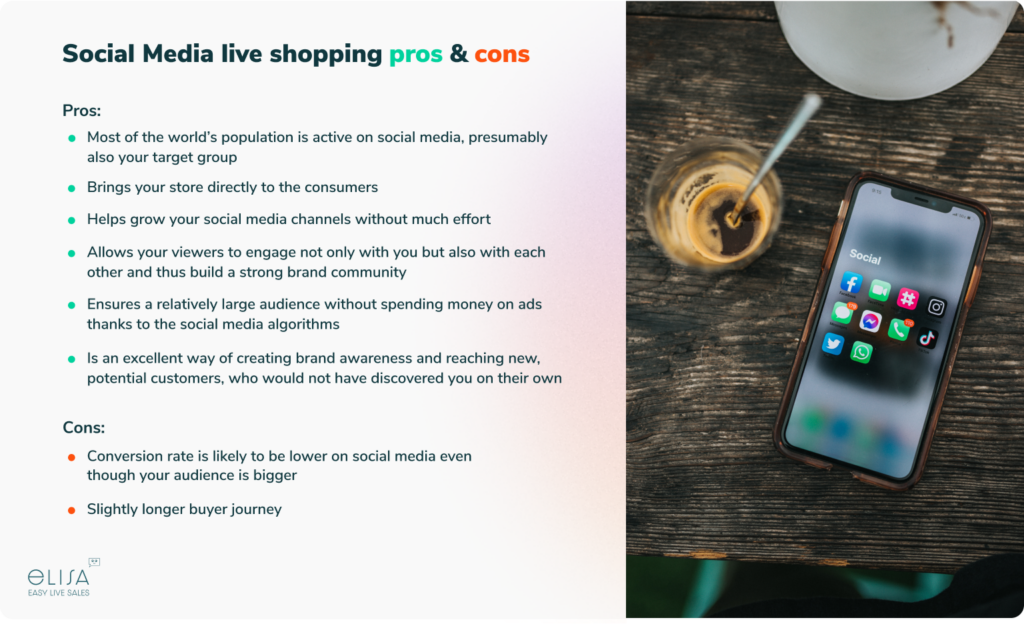
{{calculator-banner}}
Live shopping apps and platforms
How it works
Although it’s not the focus of this blog post, we cannot leave you without mentioning a third and often overlooked option when it comes to live selling: Live shopping apps.
In Asia, live shopping apps and streaming services have grown incredibly popular in recent years, and the phenomenon is now making its way to Europe. In short, a live shopping app or platform is an online marketplace created specifically for live events and shoppable videos. They put the spotlight exclusively on live shopping content, and the buying process is like a hybrid of onsite live shopping and social media live shopping.
Although the options are still limited, a growing number of live shopping apps and platforms are seeing the light of day. An excellent one is Marketplace.sprii, which was launched in October 2022. Marketplace.sprii exists both as a browser version and as an app in Google Play and App Store.

Pros
One of the benefits of a live shopping app is that you can connect with an ever-growing community of live shopping enthusiasts who are keen to explore new products and engage with new brands. People can easily be exposed to your brand, for instance on an Explore-page or by searching for specific product categories which matches your brand.
With most of the existing platforms, you can create an on-brand sales page on which you can promote your upcoming live shows and display recorded videos that are still shoppable. On some live shopping platforms such as Sprii.live, users can follow your page or save it as a favorite so your content will always appear at the top of their front page. This means that they will never miss out on your live shows again.
Cons
The downside about broadcasting your live event on a live shopping app or streaming service is that the social aspect of live shopping is not as strong as it is on social media. Just like with onsite live events, your viewers will not have the option of tagging each other and thereby share the event with others who may find it interesting. This means that creating a loyal brand community becomes challenging.
Secondly, your success depends on the success of the app. In other words, if the app or streaming service has few visitors, your videos will get few viewers as well. Likewise, if the app is not user-friendly and the buying journey is not smooth, you may lose customers. Thus, make sure to do your research in advance. We highly recommend Sprii.live, but there are other great alternatives too.
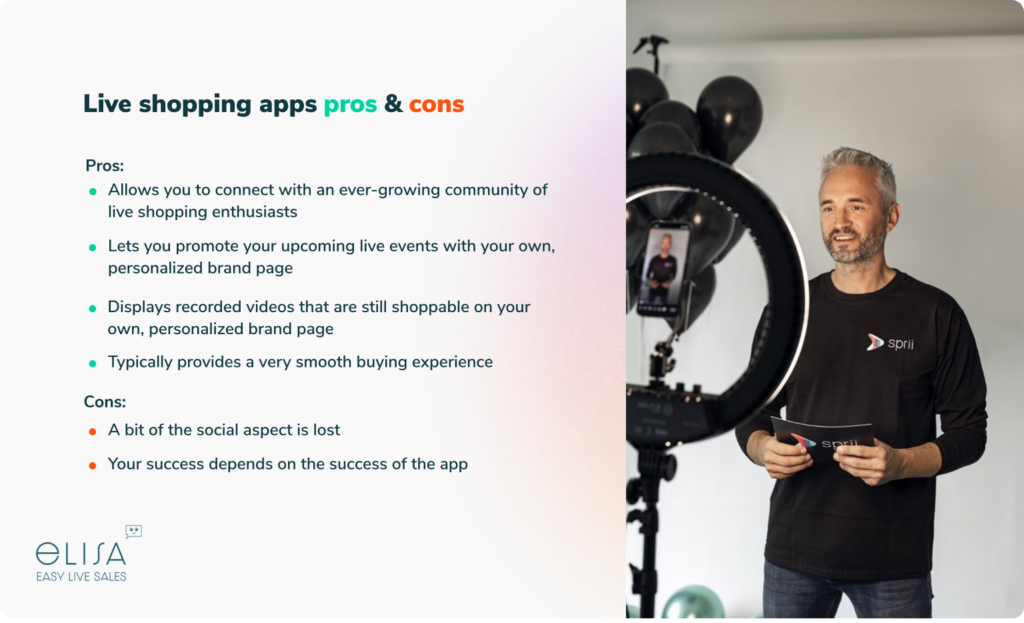
Which option do I choose?
If you have stuck with us this far, good for you! You now know the biggest pros and cons of hosting live shopping events from respectively your website, your social media channels, and dedicated live shopping apps. Your next question is bound to be: “Then which option do I choose?”
Luckily, you don’t have to choose between one or the other. Worldwide, there is a limited but number of highly professional software providers which allows you to stream your live event on multiple platforms and social media channels at once and thereby reach all your desired demographics. No need to limit yourself to one platform or channel at a time. Now you can go live on Sprii, your own website, and an unlimited number of channels on Facebook and Instagram – all at the same time.
At Sprii, we call this option “multi-streaming”. With the Sprii multi-stream feature you work smarter, not harder. During your live show, Sprii registers all incoming orders across platforms and channels. The software system also sends out automated responses to your customers including links and shipping information. Basically, you get the benefits of all the platforms mentioned above without increasing your workload even the slightest. Every time you add a new platform or an additional social media channel, you will reach more potential customers which ultimately leads to bigger revenue.
You don’t even have to jump from channel to channel to keep track of all incoming questions. The Sprii Dashboard gives you a neat overview of all comments from Facebook, Instagram, Sprii, and your own website – all gathered in one place. You can even answer all the questions directly from the Sprii Dashboard. Easy-peasy. Speaking of the Sprii Dashboard, you will also be presented with useful insights such as the number of incoming orders, the number of single products sold, the revenue gained from the event, etc.
Summary
Onsite live sales provide great opportunities to collect user data which can be used for retargeting purposes afterward. Additionally, they often have great conversion rates since the audience knows your brand from the beginning and is actively seeking your products. On the negative side, driving traffic to your website at a specific date and time is incredibly difficult and equally expensive. It is also hard to create a community onsite because your viewers do not have the option of tagging each other or sharing their experiences in the comments section. Finally, an onsite live event creates little to no brand awareness since your audience must know about you in advance to participate. Therefore, smaller brands rarely benefit from hosting onsite live sales.
In contrast, live events on social media are excellent at boosting reach and creating brand awareness, simply because the social media algorithms work in your favor. Most likely, your audience will grow exponentially every time you go live which is not the case with onsite live sales. Another advantage of social media live sales is the fact that they will help grow your social media channels and build a community around your brand. In the comments section below your videos, your viewers can engage not only with you but also with each other, which will create a strong sense of fellowship. Brands of all shapes and sizes can benefit from going live on social media.
Live shopping apps allows you to connect with an ever-growing community of live shopping enthusiasts who are keen to explore new products and engage with new brands. However, if the app is not user-friendly and the buying journey is not smooth, you may lose customers, so choose your app wisely.
Luckily, you don’t have to choose between one or the other. With the Sprii multistream feature you get the benefits of all the discussed options without suffering the disadvantages. And the best part? You don’t even have to increase your workload. Why not get the most out of your efforts?
Discover how Live Shopping
can 20X your conversions
Experience Live Shopping with Sprii
%201.webp)
.webp)
.webp)

Live Shopping event works on FB, IG and your website
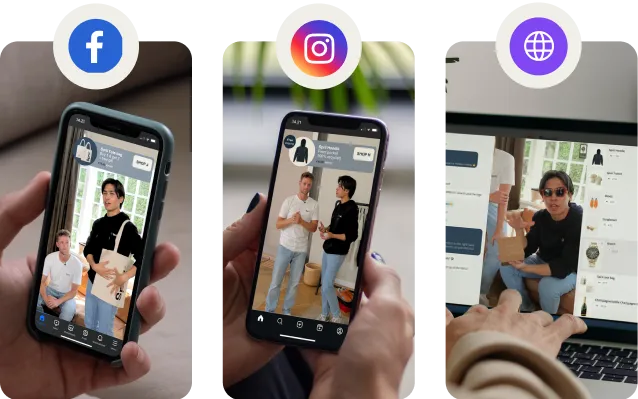
5 ways to win Black Friday

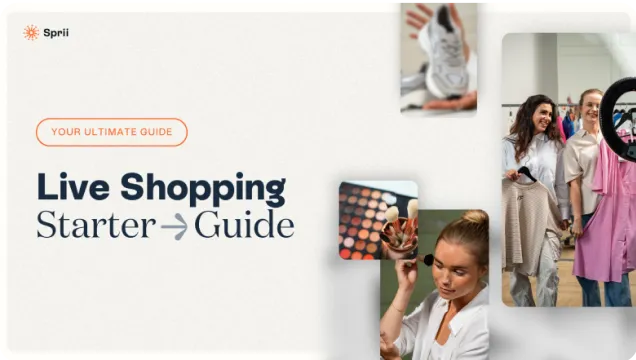



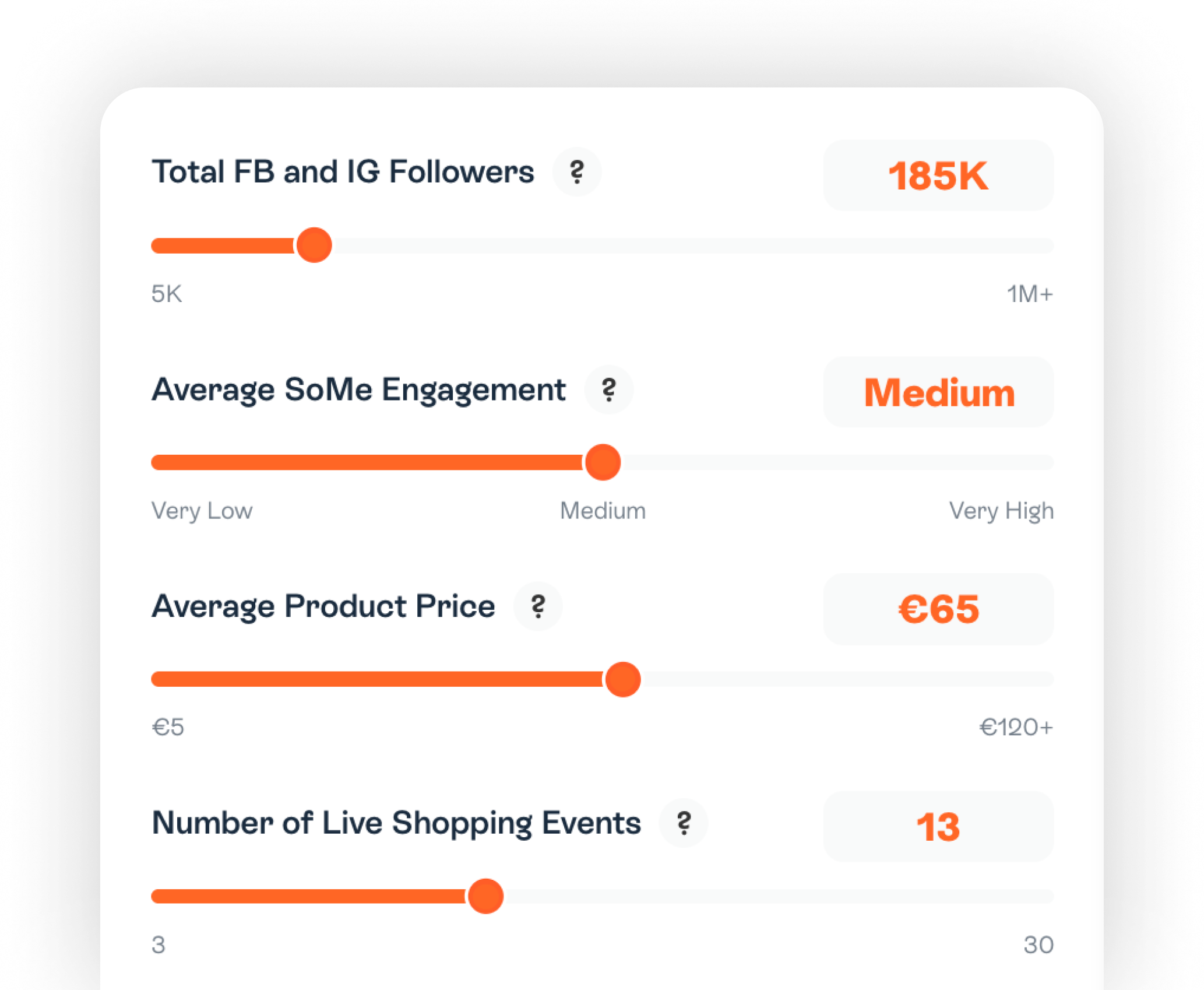















.png)